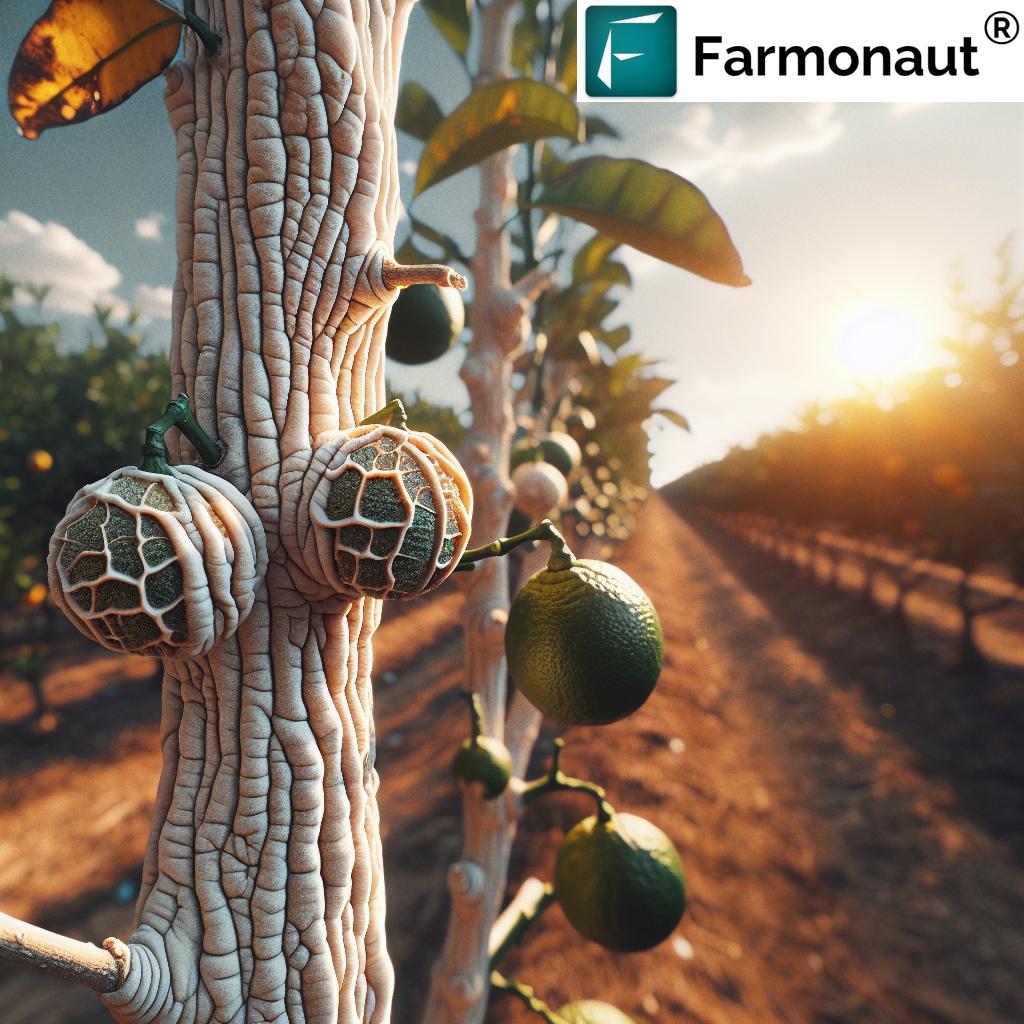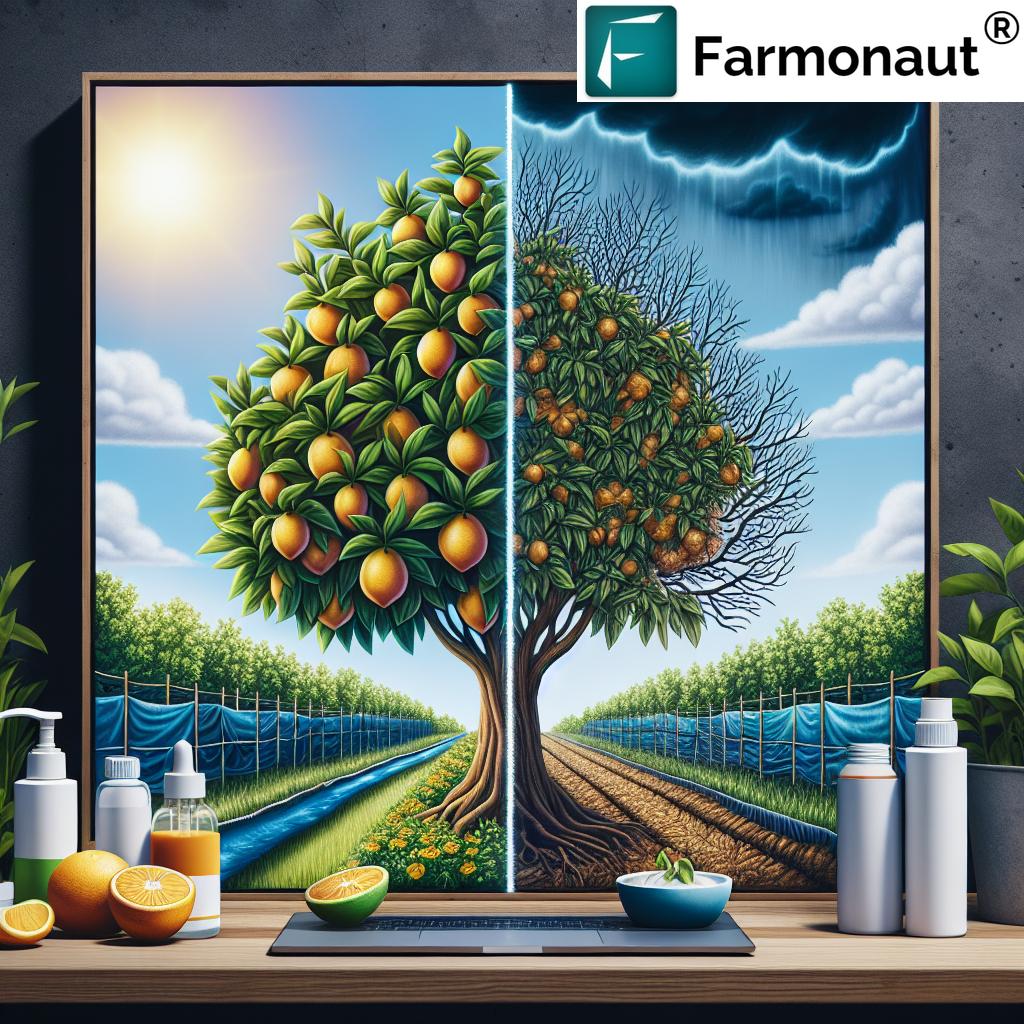Protecting Your Plants: How to Prevent Sunscald and Stress in Citrus Trees and Organic Gardens

As agricultural enthusiasts and advocates for sustainable farming practices, we at Farmonaut understand the importance of protecting your plants from environmental stressors. In this comprehensive guide, we’ll delve into the world of sunscald and plant stress, with a particular focus on citrus trees and organic gardens. We’ll explore the causes, symptoms, and most importantly, the prevention and control methods to ensure your plants thrive under even the most challenging conditions.
Understanding Sunscald: A Common Threat to Plant Health
Sunscald is a type of damage that occurs when plant tissue is exposed to intense sunlight and high temperatures. This condition is particularly problematic for trees and shrubs, especially those with thin bark or those that have been recently pruned. Citrus trees, with their susceptible nature, are often at high risk for sunscald damage.
The Science Behind Sunscald
When plants are exposed to excessive sunlight, especially during hot summer months, the intense heat can cause the plant cells to die. This damage is most common on the southwest side of trees and shrubs in the Northern Hemisphere, where the afternoon sun is strongest. The affected tissue becomes soft and wrinkled, often changing color to a white or brown hue.
Identifying Sunscald Symptoms
- Bark discoloration: Look for whitish or brownish patches on the trunk or branches.
- Cracking or peeling bark
- Exposed tissue beneath the bark
- Sunken areas on the trunk or branches
- Scorched leaves with brown or yellow patches
The Impact of Sunscald on Citrus Trees
Citrus trees are particularly susceptible to sunscald due to their thin bark and sensitivity to temperature fluctuations. The damage can be severe, affecting not only the tree’s appearance but also its overall health and productivity.
Why Citrus Trees are Vulnerable
- Thin bark: Citrus trees have relatively thin bark compared to other fruit trees, making them more susceptible to sun damage.
- Evergreen nature: Unlike deciduous trees, citrus trees retain their leaves year-round, which can lead to increased water loss and stress during hot periods.
- Shallow root systems: Citrus trees have shallow roots, making them more vulnerable to drought stress, which can exacerbate sunscald issues.
The Consequences of Sunscald on Citrus Trees
- Reduced fruit production
- Increased susceptibility to pests and diseases
- Stunted growth
- Premature leaf drop
- In severe cases, tree death
Sunscald in Organic Gardens: A Challenge for Sustainable Farming
For those practicing organic gardening methods, sunscald presents a unique challenge. Without the use of synthetic chemicals for pest control and plant protection, organic gardeners must rely on natural methods to prevent and treat sunscald.
The Organic Approach to Sunscald Prevention
- Proper plant selection: Choose varieties that are well-adapted to your local climate.
- Strategic planting: Position plants to provide mutual shade and protection.
- Natural shading techniques: Use shade cloth or other organic materials to create protective barriers.
- Soil health management: Maintain healthy soil to promote strong, resilient plants.
The Role of Environmental Stress in Sunscald Development
Environmental stress plays a significant role in the development and severity of sunscald. Understanding these stressors can help us develop more effective prevention strategies.
Key Environmental Stressors
- Drought: Lack of water can weaken plants, making them more susceptible to sun damage.
- Extreme temperature fluctuations: Rapid changes between hot and cold can stress plant tissues.
- Nutrient deficiencies: Inadequate nutrition can weaken plant defenses against environmental stressors.
- Improper pruning: Over-pruning can suddenly expose previously shaded bark to intense sunlight.
Prevention and Control Strategies for Sunscald
Preventing sunscald is far easier than treating it once it occurs. Here are some effective strategies to protect your plants:
1. Proper Pruning Techniques
Pruning is essential for plant health, but improper pruning can lead to sunscald. Follow these guidelines:
- Prune during the dormant season to minimize stress
- Avoid heavy pruning that exposes large areas of bark
- Gradually thin out dense canopies over several seasons
2. Protective Coverings
Physical barriers can provide excellent protection against sunscald:
- Tree wraps: Use light-colored, breathable materials to wrap trunks and branches
- Shade cloth: Install over vulnerable plants during peak sun hours
- Whitewashing: Apply a diluted latex paint to reflect sunlight
3. Strategic Planting
Plan your garden layout to minimize sun exposure:
- Plant shade-tolerant species on the south and west sides of your garden
- Use companion planting to provide natural shade
- Consider the mature size of plants when spacing them
4. Proper Watering and Soil Management
Healthy, well-hydrated plants are more resistant to sunscald:
- Water deeply and consistently, especially during dry periods
- Use mulch to retain soil moisture and regulate temperature
- Ensure proper drainage to prevent waterlogging
5. Nutritional Support
Provide your plants with the nutrients they need to withstand stress:
- Conduct regular soil tests to identify deficiencies
- Use organic fertilizers to boost plant health
- Apply compost to improve soil structure and nutrient content
Treating Sunscald: What to Do When Prevention Fails
Despite our best efforts, sometimes sunscald can still occur. Here’s how to treat affected plants:
- Remove damaged bark: Carefully cut away loose or damaged bark to prevent further decay
- Clean the wound: Use a mild soap solution to clean the affected area
- Apply a protective coating: Use a tree wound dressing to protect the exposed tissue
- Monitor for signs of infection: Watch for any signs of disease or pest infestation in the damaged area
- Provide extra care: Ensure the plant receives adequate water and nutrients to support healing
The Importance of Ongoing Monitoring
Regular monitoring is crucial for early detection and prevention of sunscald. At Farmonaut, we’ve developed advanced satellite-based technologies to help farmers and gardeners monitor their crops and trees more effectively.
| Feature | Traditional Methods | Farmonaut Satellite System |
|---|---|---|
| Early Detection | Manual inspection, time-consuming | Real-time satellite imagery for rapid detection |
| Precision | Limited to visual inspection | High-resolution imagery for detailed analysis |
| Coverage Area | Limited to accessible areas | Large-scale monitoring of entire orchards or farms |
| Stress Monitoring | Subjective assessment | Advanced algorithms for accurate stress level detection |
Our satellite-based monitoring system offers superior, large-scale monitoring of plant health and stress levels compared to traditional manual inspection methods. By leveraging this technology, farmers and gardeners can detect potential sunscald issues early and take proactive measures to protect their plants.
The Role of Technology in Modern Plant Protection
At Farmonaut, we’re committed to leveraging cutting-edge technology to help farmers and gardeners protect their plants from environmental stressors like sunscald. Our satellite-based monitoring system provides real-time data on plant health, allowing for early detection of stress and potential sunscald issues.
Benefits of Satellite-Based Monitoring
- Early detection of plant stress
- Large-scale monitoring capabilities
- Precise identification of affected areas
- Data-driven decision making for plant protection
To learn more about how our technology can help protect your plants, visit our app page or explore our API documentation.
FAQs About Sunscald and Plant Protection
- Q: What is the main cause of sunscald in plants?
A: Sunscald is primarily caused by intense sunlight and high temperatures damaging plant tissues, particularly on bark and leaves. - Q: Are all plants equally susceptible to sunscald?
A: No, some plants are more susceptible than others. Citrus trees, young trees, and plants with thin bark are particularly vulnerable. - Q: Can sunscald kill a tree?
A: In severe cases, sunscald can lead to significant damage and even tree death, especially if left untreated or if it leads to secondary infections. - Q: How can I protect my citrus trees from sunscald?
A: Use tree wraps, whitewash the trunk, provide adequate water, and consider using shade cloth during peak sun hours. - Q: Is sunscald more common in organic gardens?
A: Not necessarily, but organic gardeners may face additional challenges in preventing and treating sunscald without synthetic chemicals. - Q: How does Farmonaut’s technology help in preventing sunscald?
A: Our satellite-based monitoring system provides early detection of plant stress, allowing farmers to take preventive measures before sunscald becomes severe. - Q: Can pruning cause sunscald?
A: Yes, improper pruning that suddenly exposes previously shaded bark to intense sunlight can lead to sunscald. - Q: How often should I monitor my plants for signs of sunscald?
A: Regular monitoring, especially during hot summer months, is crucial. With Farmonaut’s technology, you can receive real-time updates on plant health. - Q: Are there any natural remedies for treating sunscald?
A: While prevention is best, natural remedies include applying compost tea to affected areas and using organic wound dressings. - Q: How long does it take for a tree to recover from sunscald?
A: Recovery time varies depending on the severity of the damage and the overall health of the tree. It can take several months to a year for a tree to fully recover.
Conclusion: Empowering Plant Protection with Knowledge and Technology
Understanding and preventing sunscald is crucial for maintaining healthy, productive plants, especially in citrus orchards and organic gardens. By combining traditional prevention methods with advanced monitoring technologies like those offered by Farmonaut, we can significantly reduce the risk of sunscald and other environmental stressors.
Remember, the key to successful plant protection lies in proactive measures, regular monitoring, and quick response to any signs of stress. Whether you’re a small-scale gardener or a large agricultural operation, implementing these strategies will help ensure your plants thrive, even in challenging conditions.
For more information on how Farmonaut can help you protect your plants and optimize your agricultural practices, visit our website or download our app:
Stay informed, stay prepared, and let’s work together to create healthier, more resilient plants for a sustainable future.
Subscribe to Farmonaut Services
